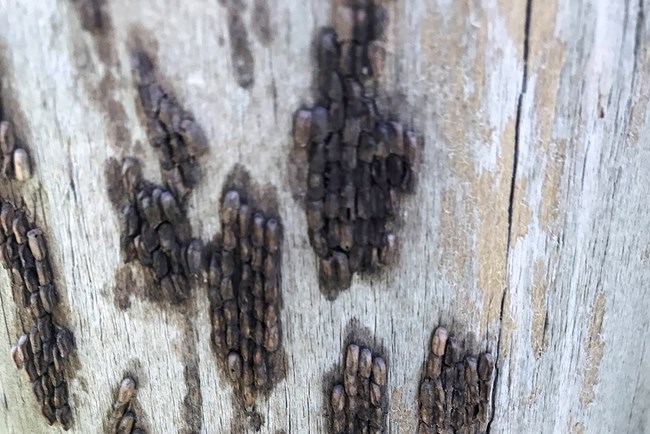Last updated: July 8, 2022
Article
Spotted Lanternflies in MORR and NJ

NPS/Shenandoah
Fast Facts
- Spotted lanterflies are an invasive species that damage economic crops and woodlands.
- Please eliminate all instances of spotted lanternfly when you see them.
- Remain vigilant to help contain the spread of the spotted lanternfly.
What is a Spotted Lanternfly?
The Spotted Lanternfly, Lycorma delicatula, also known as SLF, is an invasive insect species. Its native habitat is in Southeast Asia. It was first detected in eastern Pennsylvania in 2014, and has been spreading through the Atlantic region since then. Even though their adult form has wings, they are noticeably poor fliers. The spotted lanternfly gets around by primarily by crawling and jumping, and spreads across large distances rapdily by riding on people, their clothing, and vehicles. They are considered agricultural pests due to their destructive feeding habits.
Identifying a Spotted Lanternfly
Spotted Lanternfly hatch during the warming season of May and June. They initially appear as a dime-sized wingless black insect with white spots. Even at this early stage they are excellent jumpers and will hop away from threats...or toward a too-curious observer. As it grows and matures, the SLF grows larger and gains red stripes down its backside. Their adult stage has tan black-spotted mothlike wings and a distinct red and yellow coloring with black spots when the wings are open. Despite the wings, they still prefer to crawl and leap, being poor flyers.
Spotted lanternfly eggs begin to appear in September. Lanterfly egg masses first resemble mud smeared onto trees and other nesting sites, including the underside of motor vehicles. Over time, the mass dries and cracks, appearing lighter in color. Older egg masses resemble columns of brown seeds. Lanternfly eggs survive through the winter to hatch in May, and the cycle begins anew.

UDSA / ARS, Tracey Leskey
Why is the Spotted Lanternfly a concern?
SLF feeding habits involve piercing a plant to suck out the sap within. This process leaves a residue of honeydew, a sugary substance which attracts other insects and promotes the growth of fungus and mold. Affected plants are not killed by the lanternfly, but they are weakened as a result. Major agricultural impacts have been observed in other countries, including to fruit, vegetable, and forestry. The unchecked spread of SLF could result in major economic and ecological impacts, both in the state of New Jersey and across the nation. Therefore, many agricultural agencies at both the state and federal level have dedicated resources to monitoring, assessing, and eliminating spotted lanterfly infestations.
Are Spotted Lanternflies dangerous to children, pets, and people?
A spotted lanternfly moves quickly with a hop and fluttering wings, and can be startling! Luckily, there are no known incidents of Spotted Lanternfly stinging, biting, or otherwise attacking people, pets, and livestock. Additionally, it is not clear if lanternfly are poisonous or toxic when ingested, but there are no known incidents reported.
How can I control Spotted Lanternfly on my own property?
- Learn how to identify egg casings as well as all the life stages and monitor your property for signs of infestation. In winter, scrape egg casings into a bag and dispose of them in the trash.
- Remove or treat any Ailanthus trees with a special pesticide. These trees are also called the Tree of Heaven, they can be considered invasive, and they are preferred by spotted lanternfly as a food source.
- You may wish to set traps for spotted lanternfly on threatened trees. However, some traps could be dangerous to other wildlife, including birds and mammals. For more information about setting traps for SLF, please check here for the New Jersey Department of Agriculture's Homeowner tips.
- Encourage natural predators by avoiding spraying pesticides. Mantids and some types of birds have been observed feeding on SLF, and less pesticide use promotes a healthier natural environment for these important species
What can you do when you're in the park to slow the spread of Spotted Lanternfly?
- If you are traveling, check your vehicle periodically for lanternfly or their eggs. Lanternfly eggs appear in fall and winter, and the SLF can cling to vehicles at any stage of its life.
- If you find a spotted lanternfly in any stage of its life, remove and dispose of it. Please remember to follow all park regulations, including staying on marked trails and avoiding damage to wildlife and plants.
- Report sightings and large infestations to park staff, or by using the online reporting tool found here powered by the New Jersey Department of Agriculture. Note that hundreds of reports are generated, and while every report is valuable, not every report will create an immediate response.
For further reading:
New Jersey Department of Agriculture
National Park Service: Spotted Lanternfly 101
